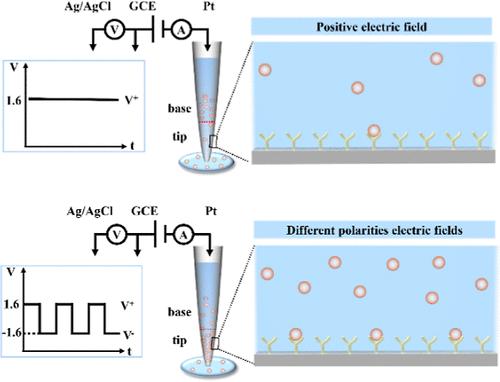当前位置:
X-MOL 学术
›
Anal. Chem.
›
论文详情
Our official English website, www.x-mol.net, welcomes your feedback! (Note: you will need to create a separate account there.)
Charge Density-Regulated Microchannel-Based Electrochemiluminescence Sensor for Hydrogen Sulfide Detection with a Highly Efficient Accumulation Strategy
Analytical Chemistry ( IF 7.4 ) Pub Date : 2024-03-21 , DOI: 10.1021/acs.analchem.3c05903 Yanling Huang 1, 2 , Huabin Cai 1 , Yue Lin 1 , Fang Luo 3 , Cuiying Lin 1 , Jian Wang 1 , Bin Qiu 1 , Zhenyu Lin 1
Analytical Chemistry ( IF 7.4 ) Pub Date : 2024-03-21 , DOI: 10.1021/acs.analchem.3c05903 Yanling Huang 1, 2 , Huabin Cai 1 , Yue Lin 1 , Fang Luo 3 , Cuiying Lin 1 , Jian Wang 1 , Bin Qiu 1 , Zhenyu Lin 1
Affiliation

|
The electrochemiluminescence (ECL) intensity can be regulated by ionic current passing through the microchannel, which broadened the regulation of the ECL sensors. But in the early reported sensors, the electrostatic repulsion and steric hindrance caused few targets to approach the interface of the microchannel driven by concentration difference, which reduced the detection efficiency and prolonged the detection period. In this study, different accumulation strategies, such as a positive electric field and different polarity electric fields, were designed to accumulate targets in the microchannel. The interaction of azide groups and hydrogen sulfide served as a research model. Hydrogen sulfide can react with the negatively charged azide groups in the microchannel surface to produce positively charged amino groups, decreasing the negative charge density of the microchannel and thus altering the ionic current and ECL intensity. The accumulation of hydrogen sulfide at the microchannel tip can increase the collision probability with azide groups to improve the detection efficiency, and the integration of accumulation and reaction can shorten the detection period to 28 min. The hydrogen sulfide concentration on the microchannel tip accumulated by applying different polarity electric fields was 22.3-fold higher than that accumulated by applying a positive electric field. The selected research model broadened the application range of a microchannel-based ECL sensor and confirmed the universality of the microchannel-based ECL sensor.
中文翻译:

基于电荷密度调节微通道的电化学发光传感器,采用高效积累策略检测硫化氢
电化学发光(ECL)强度可以通过通过微通道的离子电流来调节,这拓宽了ECL传感器的调节范围。但早期报道的传感器中,静电斥力和空间位阻导致浓度差驱动下很少有目标接近微通道界面,从而降低了检测效率并延长了检测周期。在本研究中,设计了不同的积累策略,例如正电场和不同极性电场,以在微通道中积累目标。叠氮基团和硫化氢的相互作用作为研究模型。硫化氢可以与微通道表面带负电的叠氮基反应,产生带正电的氨基,降低微通道的负电荷密度,从而改变离子电流和ECL强度。硫化氢在微通道尖端的积累可以增加与叠氮基团的碰撞概率,从而提高检测效率,并且积累和反应一体化可以将检测周期缩短至28 min。施加不同极性电场在微通道尖端累积的硫化氢浓度是施加正电场时累积的22.3倍。所选的研究模型拓宽了基于微通道的ECL传感器的应用范围,并证实了基于微通道的ECL传感器的通用性。
更新日期:2024-03-21
中文翻译:

基于电荷密度调节微通道的电化学发光传感器,采用高效积累策略检测硫化氢
电化学发光(ECL)强度可以通过通过微通道的离子电流来调节,这拓宽了ECL传感器的调节范围。但早期报道的传感器中,静电斥力和空间位阻导致浓度差驱动下很少有目标接近微通道界面,从而降低了检测效率并延长了检测周期。在本研究中,设计了不同的积累策略,例如正电场和不同极性电场,以在微通道中积累目标。叠氮基团和硫化氢的相互作用作为研究模型。硫化氢可以与微通道表面带负电的叠氮基反应,产生带正电的氨基,降低微通道的负电荷密度,从而改变离子电流和ECL强度。硫化氢在微通道尖端的积累可以增加与叠氮基团的碰撞概率,从而提高检测效率,并且积累和反应一体化可以将检测周期缩短至28 min。施加不同极性电场在微通道尖端累积的硫化氢浓度是施加正电场时累积的22.3倍。所选的研究模型拓宽了基于微通道的ECL传感器的应用范围,并证实了基于微通道的ECL传感器的通用性。



























 京公网安备 11010802027423号
京公网安备 11010802027423号